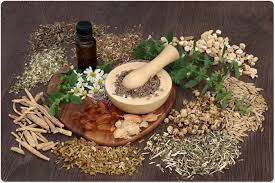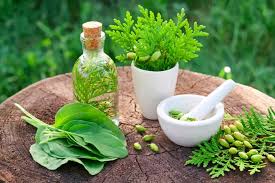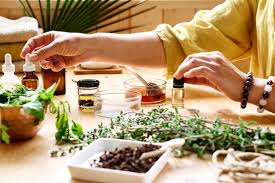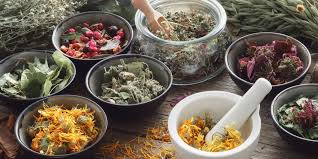Herbal remedies have been utilized for centuries as a natural approach to health and wellness. Rooted in ancient traditions, these remedies encompass a variety of practices and beliefs surrounding the use of plants for medicinal purposes.
Unlike conventional medicine, which often relies on synthetic pharmaceuticals, herbal medicine emphasizes the therapeutic properties of naturally occurring plants. This practice is grounded in the understanding that plants contain a wealth of bioactive compounds that can positively influence human health.
As modern society increasingly seeks alternatives to chemical-based treatments, the popularity of herbal remedies has surged, leading to a renewed interest in traditional healing practices.
The use of herbal remedies can be traced back to ancient civilizations such as the Egyptians, Chinese, and Indians, where plants were recognized not only for their nutritional value but also for their healing potential. In traditional Chinese medicine, for instance, herbs are carefully selected and combined to create holistic treatments that address both the physical and energetic aspects of health.
Similarly, Ayurveda, the ancient Indian system of medicine, uses a range of herbs tailored to an individual’s constitution and health needs. These age-old practices have paved the way for a deeper understanding of the potential benefits of medicinal plants, which are now supported by contemporary research and scientific validation.
The processing of medicinal plants is a crucial step in the preparation of herbal remedies. This process involves the careful extraction and preservation of the active compounds found in plants to ensure their efficacy and safety. Various methods, such as drying, grinding, and steeping, are employed to enhance the bioavailability of these compounds, making them more accessible for therapeutic use.
Moreover, the methods of processing can significantly influence the quality and potency of the final product, highlighting the importance of proper techniques in herbal medicine.
Herbal remedies can be administered in various forms, including teas, tinctures, capsules, and topical applications, each offering unique advantages depending on the intended use.
For instance, herbal teas provide a gentle way to experience the benefits of plants, while tinctures allow for concentrated doses of active ingredients. Topical applications, on the other hand, enable targeted treatment for skin conditions or localized pain. This versatility makes herbal remedies an appealing choice for many individuals seeking holistic approaches to health.
In recent years, there has been a growing body of scientific research supporting the effectiveness of many herbal remedies. Studies have shown that various herbs possess anti-inflammatory, antioxidant, and antimicrobial properties, making them valuable in the prevention and treatment of various health conditions.
For example, turmeric, a well-known herbal remedy, has been extensively studied for its anti-inflammatory effects and its role in managing chronic diseases such as arthritis. Similarly, garlic has been recognized for its cardiovascular benefits, including lowering blood pressure and cholesterol levels.
As the quest for natural and holistic health solutions continues to rise, herbal remedies remain at the forefront of alternative medicine. Their rich history, combined with modern scientific research, reinforces the potential benefits they can offer.
Understanding the principles behind herbal medicine, including the processing of medicinal plants and their applications, is essential for anyone interested in exploring these natural healing options.
History of Herbal Medicine

Herbal medicine, one of the oldest forms of healthcare, has a rich and diverse history that spans thousands of years and various cultures. It is based on the use of plants and their extracts to treat illnesses and promote overall health. This practice has evolved significantly over time, influenced by cultural beliefs, available resources, and advancements in scientific understanding.
The origins of herbal medicine can be traced back to ancient civilizations. In Egypt, around 1500 BCE, the Ebers Papyrus, one of the oldest medical texts, documented more than 700 herbal remedies. These remedies included ingredients such as garlic, juniper, and willow, showcasing the Egyptians’ advanced understanding of the medicinal properties of plants.
Similarly, in ancient China, herbal medicine has a history that dates back over 2,000 years. The Huangdi Neijing, or the Yellow Emperor’s Classic of Medicine, compiled around 300 BCE, is a foundational text of traditional Chinese medicine (TCM).
It describes the principles of balance in the body and the use of various herbs to restore harmony. Chinese herbal medicine employs a holistic approach, considering the individual’s physical and emotional health.
In India, the practice of Ayurveda has been used for over 3,000 years, focusing on the balance of body, mind, and spirit. Ayurveda emphasizes the use of herbs, diet, and lifestyle changes to prevent and treat diseases. Ancient texts like the Charaka Samhita and Sushruta Samhita detail numerous herbs and their therapeutic uses.
During the Middle Ages, herbal medicine saw a decline in Europe due to the rise of religious influence and the association of herbal practices with witchcraft.
However, monasteries became centers for herbal knowledge, preserving ancient texts and cultivating medicinal plants in their gardens. Monastic herbalists played a crucial role in maintaining herbal traditions during this period.
The Renaissance marked a resurgence in interest in herbal medicine, fueled by the rediscovery of ancient texts and increased trade with the East. Herbalists began documenting their findings in herbals books that cataloged the uses and properties of various plants. Notable herbalists from this time include Nicholas Culpeper, who published “The English Physician” in the 17th century, providing detailed descriptions of herbs and their uses in simple language for the common person.
The 18th and 19th centuries witnessed a shift in the perception of herbal medicine as scientific exploration advanced. The use of plants was increasingly scrutinized through the lens of chemistry, leading to the isolation and identification of active compounds. This period saw the development of modern pharmacology, where many herbal remedies were standardized and incorporated into mainstream medicine.
Despite the growth of pharmaceutical drugs, herbal medicine remained popular among various communities. The Eclectic Medicine movement in the United States, which emerged in the early 19th century, sought to blend traditional herbal practices with scientific principles. Eclectic physicians valued the use of botanical remedies, emphasizing a more holistic approach to healthcare.
In the 20th century, herbal medicine faced challenges as synthetic drugs dominated the healthcare landscape. However, the late 20th and early 21st centuries saw a resurgence of interest in natural remedies and holistic approaches. Increasingly, people began to seek alternatives to conventional medicine, driven by concerns over side effects and the desire for more natural solutions.
Scientific research has since validated many traditional herbal practices, leading to a growing body of evidence supporting the effectiveness of various herbs in treating specific conditions. This integration of traditional knowledge with modern scientific research has created a more comprehensive understanding of herbal medicine.
Today, herbal medicine is recognized globally, with a blend of ancient practices and modern scientific validation. While herbal remedies are widely used in alternative and complementary medicine, they have also been integrated into conventional healthcare practices.
As interest in natural and holistic health continues to grow, the history of herbal medicine serves as a testament to the enduring value of plant-based healing traditions.
Common Herbs and Their Uses
1. Basil (Ocimum basilicum): Basil is a fragrant herb commonly used in cooking and traditional medicine. It has anti-inflammatory and antibacterial properties, making it useful for digestive issues and respiratory infections. Basil tea can help soothe an upset stomach, while its essential oil can be used for aromatherapy.
2. Chamomile (Matricaria chamomilla): Chamomile is well-known for its calming effects. It is often used to alleviate anxiety, promote relaxation, and aid sleep. Chamomile tea is popular for its soothing properties, and it may also help with digestive discomfort and menstrual cramps.
3. Echinacea (Echinacea purpurea): Echinacea is commonly used to boost the immune system and prevent colds. It is thought to stimulate the body’s immune response and reduce inflammation. Echinacea supplements or teas are popular during cold and flu season to help ward off illness.
4. Ginger (Zingiber officinale): Ginger is renowned for its ability to soothe nausea and digestive issues. It has anti-inflammatory properties that can help reduce pain and swelling. Ginger tea is commonly consumed to alleviate morning sickness during pregnancy, motion sickness, and digestive discomfort.
5. Peppermint (Mentha × piperita): Peppermint is often used to relieve digestive issues and headaches. Its menthol content provides a cooling sensation that can ease nausea and improve digestion. Peppermint tea or oil can be effective in relieving tension headaches and promoting relaxation.
6. Turmeric (Curcuma longa): Turmeric contains curcumin, a compound with powerful anti-inflammatory and antioxidant properties. It is often used to support joint health, reduce inflammation, and improve overall well-being. Turmeric can be consumed in various forms, including teas, capsules, or as a spice in cooking.
7. Lavender (Lavandula angustifolia): Lavender is widely recognized for its calming and relaxing properties. It is often used in aromatherapy to reduce stress and promote sleep. Lavender oil can be used in baths or diffused in the air to create a soothing atmosphere.
8. Garlic (Allium sativum): Garlic is known for its cardiovascular benefits. It is believed to help lower blood pressure and cholesterol levels. Garlic can be consumed raw or cooked, and it is often used as a seasoning in various dishes.
Read Also: 18 Medicinal Health Benefits Of Phellodendron amurense (Amur Cork Tree)
How Herbal Remedies Work

Herbal remedies work through a combination of biochemical interactions and traditional practices. Here’s a breakdown of how they may exert their effects:
1. Active Compounds: Many herbs contain active compounds that have medicinal properties. For example, flavonoids in chamomile may have anti-inflammatory effects, while curcumin in turmeric has potent antioxidant properties. These compounds interact with the body’s biological systems to produce therapeutic effects.
2. Synergistic Effects: The combination of various compounds in herbs can create a synergistic effect, where the overall benefit is greater than the sum of individual components. For instance, the combination of ginger and honey in tea can enhance the anti-nausea effects compared to consuming either ingredient alone.
3. Modulation of Body Systems: Herbal remedies can influence different body systems. For example, adaptogenic herbs like ashwagandha help the body adapt to stress by regulating cortisol levels, while immune-boosting herbs like echinacea can stimulate the immune response.
4. Placebo Effect: The placebo effect can also play a role in how herbal remedies work. The belief that a remedy will help can lead to real physiological changes, enhancing its effectiveness. The ritual of preparing and consuming herbal remedies can provide comfort and emotional support.
5. Individual Variability: The effectiveness of herbal remedies can vary from person to person due to factors like genetics, overall health, and lifestyle. What works for one individual may not produce the same results in another. This variability highlights the importance of personalized approaches in herbal medicine.
Preparing Herbal Remedies
1. Herbal Teas: Herbal teas are one of the simplest ways to prepare herbal remedies. To make herbal tea, steep dried herbs in boiling water for about 5 to 10 minutes. Use one to two teaspoons of dried herbs per cup of water. Strain the herbs and enjoy the infusion. Common herbs for tea include chamomile, peppermint, and ginger.
2. Tinctures: Tinctures are concentrated herbal extracts made by soaking herbs in alcohol or vinegar. To prepare a tincture, fill a jar with fresh or dried herbs and cover them with alcohol (like vodka) or vinegar. Seal the jar and let it steep for several weeks, shaking it occasionally. Afterward, strain the liquid through a cheesecloth or fine mesh strainer and store it in a dark glass bottle. Tinctures can be taken in small doses, typically a few drops to a teaspoon.
3. Infused Oils: Infused oils are used in topical applications and can be made by infusing herbs in a carrier oil, such as olive or coconut oil. Fill a jar with dried herbs and cover them with oil. Seal the jar and place it in a warm, sunny spot for two to four weeks. Strain the oil and store it in a cool, dark place. Infused oils can be used for massages or in homemade salves.
4. Herbal Salves: Herbal salves are made by combining infused oils with beeswax to create a thick, topical ointment. To prepare a salve, melt beeswax in a double boiler, then mix in the infused oil until well combined. Pour the mixture into small jars or tins and let it cool. Herbal salves can be used for skin conditions, minor wounds, or moisturizing.
5. Powders and Capsules: Dried herbs can be ground into powders for easy consumption. Use a mortar and pestle or a grinder to make a fine powder, which can then be encapsulated using empty capsules or added to smoothies and other foods. This method is commonly used for potent herbs like turmeric and spirulina.
6. Decoctions: Decoctions are used for harder plant parts like roots and bark. To make a decoction, simmer the herbs in water for 20 to 30 minutes, then strain and consume. This method is effective for extracting beneficial compounds from tougher materials.
Safety and Side Effects

1. Safety Concerns: While many herbs are generally safe when used appropriately, they can pose risks, especially when misused. Factors such as the herb’s potency, the individual’s health status, dosage, and potential interactions with other medications can affect safety. Always consult a healthcare professional before starting any new herbal remedy.
2. Allergic Reactions: Some individuals may experience allergic reactions to certain herbs. Symptoms can range from mild, such as skin rashes, to severe, including difficulty breathing. It’s important to perform a patch test when using a new herbal topical preparation and to discontinue use immediately if an allergic reaction occurs.
3. Drug Interactions: Herbal remedies can interact with prescription and over-the-counter medications. For example, St. John’s Wort can interfere with the effectiveness of antidepressants and birth control pills, while garlic may enhance the effects of blood-thinning medications, leading to an increased risk of bleeding. Always inform your healthcare provider about any herbal supplements you are taking.
4. Toxicity: Some herbs can be toxic in high doses or when used improperly. For example, comfrey and kava have been linked to liver damage when consumed in large quantities or over extended periods. Be sure to use herbs at recommended dosages and for specified durations.
5. Quality and Contamination: The quality of herbal products can vary significantly. Contaminants, such as heavy metals or pesticides, may be present in poorly regulated herbal supplements. Always choose products from reputable manufacturers that follow good manufacturing practices and conduct third-party testing.
6. Pregnancy and Nursing: Certain herbs may not be safe for pregnant or nursing women. For instance, herbs like sage and peppermint can stimulate uterine contractions, while others may affect milk production. Pregnant or nursing individuals should consult their healthcare provider before using herbal remedies.
Herbal Remedies for Common Ailments
1. Cold and Flu: Echinacea is often used to boost the immune system and may help reduce the duration of colds. Elderberry syrup is also popular for its antiviral properties, helping to alleviate cold symptoms and support recovery.
2. Digestive Issues: Ginger is commonly used to relieve nausea and digestive discomfort. It can help soothe upset stomachs and reduce bloating. Peppermint tea is effective for easing digestive issues and can relax the muscles of the gastrointestinal tract.
3. Stress and Anxiety: Chamomile is known for its calming effects and is often consumed as tea to promote relaxation and sleep. Lavender essential oil can be used in aromatherapy to reduce anxiety and improve mood.
4. Inflammation and Pain: Turmeric, with its active compound curcumin, is renowned for its anti-inflammatory properties. It can help relieve pain associated with arthritis and other inflammatory conditions. Willow bark has been traditionally used for pain relief, similar to aspirin.
5. Skin Conditions: Aloe vera is widely used for its soothing properties on sunburns, cuts, and other skin irritations. Calendula can also be applied topically to promote healing and reduce inflammation.
6. Sleep Disorders: Valerian root is commonly used as a natural remedy for insomnia and other sleep disorders. It can help improve sleep quality and reduce the time it takes to fall asleep.
Integrating Herbal Remedies with Conventional Medicine
1. Open Communication: It’s crucial to communicate openly with your healthcare provider about your use of herbal remedies. This helps ensure that your healthcare provider can monitor potential interactions and provide informed recommendations.
2. Complementary Approach: Herbal remedies can complement conventional medicine by enhancing overall wellness. For example, while undergoing treatment for chronic pain, a patient may use turmeric to help manage inflammation and discomfort in conjunction with prescribed medications.
3. Personalized Treatment Plans: Each individual’s health needs are unique. A healthcare provider can help tailor a treatment plan that incorporates both herbal remedies and conventional medicine to address specific health concerns effectively.
4. Evidence-Based Practice: Research on the effectiveness of herbal remedies is growing. Patients should seek guidance from healthcare professionals who are knowledgeable about both herbal and conventional treatments to make informed decisions based on scientific evidence.
5. Monitoring and Adjustments: When integrating herbal remedies, it’s essential to monitor their effects on health. If a patient experiences side effects or interactions, adjustments can be made to the treatment plan. Regular follow-ups with healthcare providers can ensure that both herbal and conventional approaches work harmoniously.
6. Education and Research: Patients should educate themselves about the herbs they intend to use. Understanding the benefits, potential side effects, and interactions with medications can empower individuals to make safe and informed choices.
Read Also: What are the Differences Between Broccoli and Cauliflower?
The Role of Herbal Remedies in Holistic Health

1. Mind-Body Connection: Herbal remedies are often used in holistic health practices to support the mind-body connection. Herbs like St. John’s Wort are known for their mood-lifting properties, helping to alleviate symptoms of depression and anxiety, thereby promoting overall mental well-being.
2. Natural Healing: Holistic health emphasizes the body’s ability to heal itself. Many herbal remedies, such as echinacea for immune support or ginger for digestive health, can aid the body in its natural healing processes, enhancing recovery from illnesses without harsh side effects.
3. Preventive Care: Herbal remedies are frequently used for preventive care, aiming to maintain health rather than simply treating symptoms. For example, garlic is known for its cardiovascular benefits, helping to lower blood pressure and cholesterol levels, thereby reducing the risk of heart disease.
4. Personalized Treatment: Holistic health recognizes that each person is unique. Herbal remedies can be tailored to individual needs and health conditions, allowing for personalized treatment plans. For instance, someone with digestive issues might benefit from peppermint, while another person might need chamomile for its calming effects.
5. Lifestyle Integration: Incorporating herbal remedies into daily routines can promote a healthy lifestyle. Herbal teas, tinctures, and supplements can be integrated into diets and wellness practices, making it easier for individuals to prioritize their health.
6. Synergy with Other Therapies: Herbal remedies can work synergistically with other holistic therapies such as acupuncture, yoga, and massage therapy. For example, using valerian root alongside meditation can enhance relaxation and improve sleep quality.
Growing Your Own Medicinal Herbs
1. Choosing the Right Herbs: Start by selecting herbs that are suited for your needs and growing conditions. Popular medicinal herbs include basil, mint, lavender, and rosemary, which can be grown in containers or gardens. Research each herb’s specific growing requirements to ensure success.
2. Site Preparation: Choose a location that receives ample sunlight, as most medicinal herbs thrive in bright light. Prepare the soil by ensuring good drainage and incorporating organic matter, such as compost, to enrich the soil with nutrients.
3. Planting Techniques: Sow seeds or transplant seedlings into the prepared soil, following the recommended planting depth and spacing for each herb. Ensure adequate moisture during the initial growth phase, but avoid overwatering, which can lead to root rot.
4. Care and Maintenance: Regularly water your herbs, keeping the soil consistently moist but not soggy. Fertilize as needed with organic fertilizers to promote healthy growth. Prune and harvest your herbs regularly to encourage new growth and prevent overcrowding.
5. Pest and Disease Management: Monitor your plants for signs of pests or diseases. Use natural pest control methods, such as introducing beneficial insects or using neem oil, to protect your herbs without harmful chemicals. Healthy plants are less susceptible to disease, so maintaining proper care is essential.
6. Harvesting and Drying: Harvest herbs when they are at their peak potency, typically just before flowering. Cut the stems and hang them upside down in a dark, dry place to air-dry. Once dried, store your herbs in airtight containers away from sunlight to preserve their potency and flavor.
Legal and Regulatory Aspects of Herbal Remedies
1. Regulatory Framework: The regulation of herbal remedies varies widely across countries. In many places, herbal products are classified as dietary supplements rather than medications, which can affect the level of oversight and quality control.
2. Quality Standards: Regulatory bodies, such as the U.S. Food and Drug Administration (FDA) and the European Medicines Agency (EMA), set guidelines for the quality and labeling of herbal products. However, unlike pharmaceuticals, herbal products may not undergo rigorous pre-market approval processes, leading to variations in quality and efficacy.
3. Labeling Requirements: In many countries, herbal remedies must be labeled accurately to inform consumers of their ingredients, intended use, and potential side effects. Labels should also include any necessary warnings regarding interactions with medications or conditions.
4. Good Manufacturing Practices (GMP): Manufacturers of herbal products are often encouraged or required to follow Good Manufacturing Practices (GMP) to ensure consistency and safety in production. This includes quality control measures to verify the identity, purity, and strength of herbal ingredients.
5. Research and Claims: Claims made by manufacturers about the effectiveness of herbal remedies should be supported by scientific evidence. In some jurisdictions, making unverified health claims can lead to legal issues. Consumers are encouraged to seek products backed by research.
6. Intellectual Property Rights: The use of traditional knowledge in herbal medicine can lead to intellectual property disputes. Countries may have laws in place to protect indigenous knowledge and practices related to herbal remedies, ensuring fair use and benefit-sharing.
Do you have any questions, suggestions, or contributions? If so, please feel free to use the comment box below to share your thoughts. We also encourage you to kindly share this information with others who might benefit from it. Since we can’t reach everyone at once, we truly appreciate your help in spreading the word. Thank you so much for your support and for sharing!
Read Also: The Different Types of Fertilizers and How they Work
Frequently Asked Questions
We will update this section soon.

